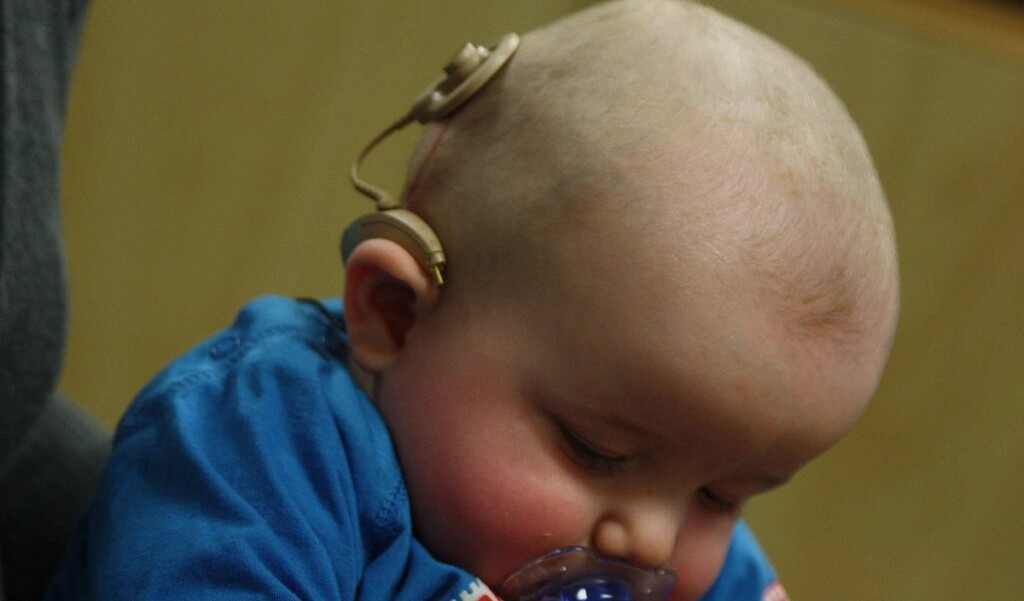
Biotech engineers have developed the primary fully inside cochlear implant that may enable customers to maneuver, train, swim, and luxuriate in a full vary of human actions with out worrying about exterior {hardware}.
This exterior {hardware} usually sits on high of the ear or across the head and prohibits all method of vigorous actions—together with sleep, for the reason that machine presses towards the comfortable bones of the temple.
Regardless of these hindrances, cochlear implants are one of the widely-used items of biotech on Earth, and have allowed over a million folks to listen to the world round them.
This doesn’t simply embrace older folks whose listening to has gone, however infants born deaf or arduous of listening to who desperately want noise, notably human voices, for regular social and academic growth.
However as a result of infants don’t understand the significance of the implant for his or her growth, they’re liable to try to fiddle, or take away fully, the exterior {hardware}, and with no different possibility, mother and father and physicians have to use medical tape or childproof headgear that forestalls them from eradicating it.
To try to take away this burden from all cochlear customers, researchers at MIT, Massachusetts Eye and Ear, Harvard Medical College, and Columbia College have pioneered the primary cochlear implant that’s fully surgically inserted.
Its novel design depends on the single-direction vibrations of a bone within the center a part of listening to canal known as the umbo.
The workforce needed to tackle many challenges to provide their prototype. The umbo vibrations are measured in nanometers—requiring an especially delicate microphone. A microphone so delicate would additionally must have gating properties to dam the equally loud sound of the electronics working inside it. It could additionally should measure within the low millimeters.
Any implantable sensors would even have to deal with the dynamic fluid and sizzling setting of the human physique. Nonetheless, a totally implantable cochlear machine would have main benefits as properly. As a result of they’re mounted on the edges of the top, the audio amplification machine can’t avail the consumer of the noise filtering and sound localization cues supplied by the construction of the outer ear.
MORE BIOTECH ADVANCES: Bioengineered Corneas Stand to Remedy Blindness For Hundreds of thousands of Folks Across the World
The workforce overcame all these obstacles to create the UmboMic, a triangular, 3-millimeter by 3-millimeter movement sensor. It’s composed of a ‘piezoelectric’ materials known as polyvinylidene difluoride (PVDF). Piezoelectric supplies generate electrical cost when compressed or stretched, and when positioned simply barely towards the umbo, the listening to bone’s vibrations generate the cost that powers the machine.
The PVDF sandwiches a versatile printed circuit board, and to maximise the machine’s efficiency, a low-noise amplifier enhances the sign whereas minimizing noise from the electronics. No amplifier that match the groups’ specs existed, so that they needed to construct their very own.
Karl Grosh, a professor of mechanical engineering on the College of Michigan who didn’t take part within the analysis or growth, advised MIT Press that the capabilities of this completely new invention are each stunning and spectacular.
MEDICAL TECH FOR THE FUTURE: UK Boy Has Mind Implant Fitted to Management Epilepsy Seizures in World First
“The results in this paper show the necessary broad-band response and low noise needed to act as an acoustic sensor,” stated Grosh.
“This result is surprising, because the bandwidth and noise floor are so competitive with the commercial hearing aid microphone. This performance shows the promise of the approach, which should inspire others to adopt this concept.”
The workforce is now transferring into animal trials.
SHARE This Unbelievable Micro-Engineering Job With Your Pals…




